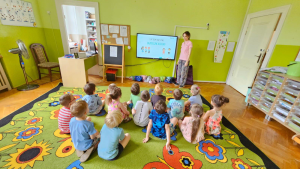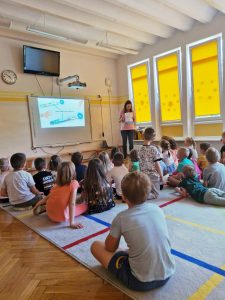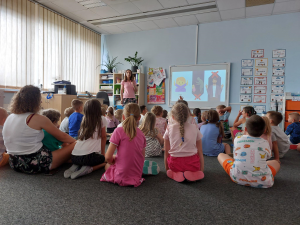The second edition of a workshop for children about safety in the mall and beyond is behind us.
With preschoolers about safety
The idea for the workshop came about last year, when we found that both as safety professionals and as parents we felt the need to educate the youngest on how to behave safely in crowded places. Many of our employees have children and we realize how difficult going out together – to the park, shopping, meeting friends – can sometimes be. As a company professionally involved in the security of shopping malls, among other things, we know what to look out for, because we observe families in stores every day and know how creative and fast kids can be.
Presentation and discussion
Our workshops are based on a simple, colorful presentation, which is the basis for discussions with preschoolers. Toddlers won’t sit for long simply listening to what they are allowed and not allowed to do in the store, so meeting facilitators pretend to look for a lost child or approach a security guard, ask children questions and engage them in conversation. Clear pictures depict everyday situations in the mall (common areas, escalators, elevator, parking lot), and the facilitators, together with the children, determine what behavior will keep them safe and what risks, for example, falling or getting lost.
When I get lost…
An important part of the workshop is to show children how getting lost happens and how to find their parents. We start by telling how one can get lost and that often a seemingly innocent game of tag or hide-and-seek results in losing sight of caregivers. We analyze what children and parents feel at such a moment, and cite examples from our own lives. We repeat with the children the most important rules:
- I see the parent, the parent sees me,
- when I get lost, I go to the security guard or cashier.
We recommend that if you get lost in a shopping mall or store, you approach a security guard or a salesperson, because in this way you can quickly convey the message about a lost child through the facility’s loudspeakers. What’s more, the specific place where the child is waiting is then indicated, so that the parent doesn’t run around the center in a panic, but goes straight for the child. The toddler, knowing that he is in the care of an adult who is waiting with him for the caregivers, also feels calmer.
We always try to avoid situations where one is looking for the other, i.e. the parents are looking for the child and the child is looking for the parents. In this way, both can pass each other, being just 2 alleys away, without even knowing it.
NO!
In addition to the standard rules for safety on escalators, in the elevator, or in the parking lot, among others, we sensitize children to situations when they are accosted by strange adults. It is surprising and disturbing to hear preschoolers admit that they have been puzzled by strangers and, for example, offered to look at animals in the car. Some stories told by older groups show how vigilant we need to be. A girl from kindergarten told how, while walking with her friends and parents at a distance behind them in the park, a gentleman regularly approached them for several days and handed them bracelets or bead necklaces. All but one of them refused, fortunately, after some time the girls’ guardians intervened and saw from a distance that their daughters were talking to a man. Systematic appearances around playgrounds or playgrounds are aimed at taming children with the image, and thus building trust.
Therefore, we teach children to say “no!” loudly and clearly. We teach them not to accept any sweets or gifts from people they don’t know, and if strangers start to physically accost them – shout, kick, beat and run away. This may seem drastic, but it is good for children to know that not all adults have positive intentions and that they can refuse adults. We do shouting exercises with kindergarteners; they are supposed to be so loud as to scare off the person accosting them and get the attention of the other people around them.
Talking is the key
Regardless of what we teach children at the workshop, however, the most important thing is for parents to talk to their children. Set your rules: when someone gets lost, what does he do? Does he wait where they last saw each other? Does he go to an agreed place? Seeks help from a security guard or a woman with children? It is crucial that the child be clear about these rules.
Rehearse various scenes – this way we get used to unusual situations and model desired behavior. Involve children in preparing lists, shopping, packing for the vacations; toddlers feel important when they have tasks to do, and by focusing on them, they make it easier for us, their caregivers, to carry out daily chores.
Let’s talk to our children and be open to what they want to tell us.















